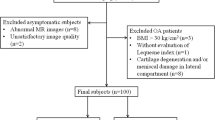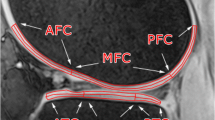Abstract
Objective
This study compares the performance and the reproducibility of quantitative T2, T2* and the magnetisation transfer ratio (MTR) of articular cartilage at 7T and 3T.
Methods
Axial MRI of the patella was performed in 17 knees of healthy volunteers (25.8 ± 5.7 years) at 3T and 7T using a comparable surface coil and whole-body MR systems from the same vendor, side-by-side. Thirteen knee joints were assessed once, and four knee joints were measured three times to assess reproducibility. T2 relaxation was prepared by a multi-echo, spin-echo sequence and T2* relaxation by a multi-echo, gradient-echo sequence. MTR was based on a magnetisation transfer-sensitized, steady-state free precession approach. Statistical analysis-of-variance and coefficient-of-variation (CV) were prepared.
Results
For T2 and T2*, global values were significantly lower at 7T compared with 3T; the zonal evaluation revealed significantly less pronounced stratification at 7T (p < 0.05). MTR provided higher values at 7T (p < 0.05). CV, indicating reproducibility, showed slightly lower values at 7T, but only for T2 and T2*.
Conclusion
Although lower T2 and T2* relaxation times were expected at 7T, the differences in stratification between the field strengths were reported for the first time. The assessment of MT is feasible at 7T, but requires further investigation.




Similar content being viewed by others
References
Felson DT (2004) Risk factors for osteoarthritis: understanding joint vulnerability. Clin Orthop Relat Res:S16-21
Potter HG, Black BR, le Chong R (2009) New techniques in articular cartilage imaging. Clin Sports Med 28:77–94
Welsch GH, Mamisch TC, Hughes T, Domayer S, Marlovits S, Trattnig S (2008) Advanced morphological and biochemical magnetic resonance imaging of cartilage repair procedures in the knee joint at 3 Tesla. Semin Musculoskelet Radiol 12:196–211
Regatte RR, Schweitzer ME (2008) Novel contrast mechanisms at 3 Tesla and 7 Tesla. Semin Musculoskelet Radiol 12:266–280
Burstein D, Velyvis J, Scott KT et al (2001) Protocol issues for delayed Gd(DTPA)(2-)-enhanced MRI: (dGEMRIC) for clinical evaluation of articular cartilage. Magnetic Resonance in Medicine 45:36–41
Mosher TJ, Dardzinski BJ (2004) Cartilage MRI T2 relaxation time mapping: overview and applications. Semin Musculoskelet Radiol 8:355–368
Potter K, Butler JJ, Horton WE, Spencer RG (2000) Response of engineered cartilage tissue to biochemical agents as studied by proton magnetic resonance microscopy. Arthritis Rheum 43:1580–1590
Pakin SK, Cavalcanti C, La Rocca R, Schweitzer ME, Regatte RR (2006) Ultra-high-field MRI of knee joint at 7.0T: preliminary experience. Acad Radiol 13:1135–1142
Welsch GH, Mamisch TC, Hughes T et al (2008) In vivo biochemical 7.0 Tesla magnetic resonance: preliminary results of dGEMRIC, zonal T2, and T2* mapping of articular cartilage. Invest Radiol 43:619–626
Bieri O, Scheffler K (2007) Optimized balanced steady-state free precession magnetization transfer imaging. Magn Reson Med 58:511–518
Welsch GH, Trattnig S, Scheffler K et al (2008) Magnetization transfer contrast and T2 mapping in the evaluation of cartilage repair tissue with 3T MRI. J Magn Reson Imaging 28:979–986
Liess C, Lusse S, Karger N, Heller M, Gluer CC (2002) Detection of changes in cartilage water content using MRI T2-mapping in vivo. Osteoarthritis Cartilage 10:907–913
Goodwin DW, Wadghiri YZ, Dunn JF (1998) Micro-imaging of articular cartilage: T2, proton density, and the magic angle effect. Acad Radiol 5:790–798
Goodwin DW, Zhu H, Dunn JF (2000) In vitro MR imaging of hyaline cartilage: correlation with scanning electron microscopy. AJR Am J Roentgenol 174:405–409
Rubenstein JD, Kim JK, Morova-Protzner I, Stanchev PL, Henkelman RM (1993) Effects of collagen orientation on MR imaging characteristics of bovine articular cartilage. Radiology 188:219–226
Mosher TJ, Collins CM, Smith HE et al (2004) Effect of gender on in vivo cartilage magnetic resonance imaging T2 mapping. J Magn Reson Imaging 19:323–328
Smith HE, Mosher TJ, Dardzinski BJ et al (2001) Spatial variation in cartilage T2 of the knee. J Magn Reson Imaging 14:50–55
Welsch GH, Mamisch TC, Domayer SE et al (2008) Cartilage T2 assessment at 3-T MR imaging: in vivo differentiation of normal hyaline cartilage from reparative tissue after two cartilage repair procedures–initial experience. Radiology 247:154–161
Welsch GH, Mamisch TC, Marlovits S et al (2009) Quantitative T2 mapping during follow-up after matrix-associated autologous chondrocyte transplantation (MACT): Full-thickness and zonal evaluation to visualize the maturation of cartilage repair tissue. J Orthop Res 27:957–963
Mlynarik V, Degrassi A, Toffanin R, Vittur F, Cova M, Pozzi-Mucelli RS (1996) Investigation of laminar appearance of articular cartilage by means of magnetic resonance microscopy. Magn Reson Imaging 14:435–442
Mlynarik V, Szomolanyi P, Toffanin R, Vittur F, Trattnig S (2004) Transverse relaxation mechanisms in articular cartilage. J Magn Reson 169:300–307
Bittersohl B, Hosalkar HS, Hughes T et al (2009) Feasibility of T2* mapping for the evaluation of hip joint cartilage at 1.5T using a three-dimensional (3D), gradient-echo (GRE) sequence: a prospective study. Magn Reson Med 62:896–901
Welsch GH, Trattnig S, Hughes T et al (2009) T2 and T2* mapping in patients after matrix-associated autologous chondrocyte transplantation: initial results on clinical use with 3.0-Tesla MRI. Eur Radiol 19:1253–1262
Maroudas A, Bayliss MT, Venn MF (1980) Further studies on the composition of human femoral head cartilage. Ann Rheum Dis 39:514–523
Quaia E, Toffanin R, Guglielmi G et al (2008) Fast T2 mapping of the patellar articular cartilage with gradient and spin-echo magnetic resonance imaging at 1.5T: validation and initial clinical experience in patients with osteoarthritis. Skeletal Radiol 37:511–517
Hannila I, Raina SS, Tervonen O, Ojala R, Nieminen MT (2009) Topographical variation of T2 relaxation time in the young adult knee cartilage at 1.5T. Osteoarthritis Cartilage 17:1570–1575
Mosher TJ, Liu Y, Torok CM (2010) Functional cartilage MRI T2 mapping: evaluating the effect of age and training on knee cartilage response to running. Osteoarthritis Cartilage 18:358–364
Welsch GH, Mamisch TC, Quirbach S, Zak L, Marlovits S, Trattnig S (2009) Evaluation and comparison of cartilage repair tissue of the patella and medial femoral condyle by using morphological MRI and biochemical zonal T2 mapping. Eur Radiol 19:1253–1262
Mamisch TC, Trattnig S, Quirbach S, Marlovits S, White LM, Welsch GH (2010) Quantitative T2 Mapping of Knee Cartilage: Differentiation of Healthy Control Cartilage and Cartilage Repair Tissue in the Knee with Unloading–Initial Results. Radiology 254:812–826
Stehling C, Liebl H, Krug R et al (2010) Patellar cartilage: T2 values and morphologic abnormalities at 3.0-T MR imaging in relation to physical activity in asymptomatic subjects from the osteoarthritis initiative. Radiology 254:509–520
Acknowledgments
Funding for this study was provided by the project “Vienna Advanced Clinical Imaging Center” (VIACLIC), within the “Vienna Spots Of Excellence” program; a collaboration of the Medical University of Vienna and Siemens Austria.
Author information
Authors and Affiliations
Corresponding author
Rights and permissions
About this article
Cite this article
Welsch, G.H., Apprich, S., Zbyn, S. et al. Biochemical (T2, T2* and magnetisation transfer ratio) MRI of knee cartilage: feasibility at ultra-high field (7T) compared with high field (3T) strength. Eur Radiol 21, 1136–1143 (2011). https://doi.org/10.1007/s00330-010-2029-7
Received:
Revised:
Accepted:
Published:
Issue Date:
DOI: https://doi.org/10.1007/s00330-010-2029-7




